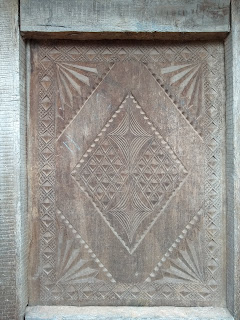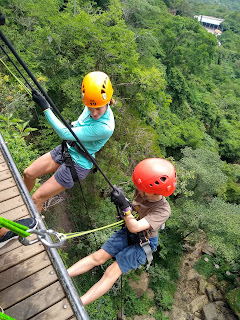Zafimaniry Villages
This is Adam. Yes, the one who has yet to contribute to the blog. Rest assured that I have played an important managerial role behind the scenes, always full of suggestions about what others should write posts about. But this time, It's all me!
It has been great taking the kids to many of our favorite places in Madagascar. At the same time, we also wanted to discover some places we didn't manage to get to during our time here. And more than anything, we wanted the kids to experience true village life. So, we decided to take a hiking trip to visit a group of remote Zafimaniry villages, located to the east of Ambositra.
If you have ever been to our home, one of the first things you see when you come through the front door is a carved wooden chest. This was made by Zafimaniry artisans who have been carving their symmetrical, geometric shapes since the time of the Kings in Madagascar. They live in very simple, one room wooden homes. There is an open fire pit just inside the door, where they do the cooking, and other corners of the room are reserved for tools, animals, and sleeping. It is about as basic as it gets. The one unique feature of the homes, however, are the carved wood doors and shutters.
With our guide, we drove about 2 hours from Ambositra to the end of the road (literally) to the first Zafimairy village of Antoetra. It was only when we climbed out of the vehicle that we noticed the live chickens that had been travelling under the seats. Resting quietly in a bag, they were along for the ride--at least until meal time.
After a night in Antoetra, we set off hiking toward our first destination: Sakaivo. Because it was market day in Antoetra, there was a constant stream of people coming from Sakaivo. While our packs felt a bit heavy, it was humbling to see people carrying huge loads on their heads. Our respect grew only stronger as we reached the summit of our trek, followed by a harrowing decent to the village. It was hard to believe the villagers needed to make this trip each time they went to the market!
The skies opened up and the trail turned into a muddy stream, interspersed with small waterfalls. Loic, who had been somewhat luke-warm on the whole trek suddenly became incredibly enthusiastic, splashing around and improvising water slides.
Even more than the great hiking, the highlight was the village stays. This was about as rustic an experience as Celia and I have ever had, and it was a serious test for the kids. No electricity, no running water, a hole-in-the-ground toilet located half-way across the village... As we told the kids, this was their mini Peace Corps experience.

We were also on full display for the large kid populations. While it is fairly common for foreigners to pass through, it is extremely rare to see foreign children. The village kids made no effort to hide their fascination, huddling around the windows and doors of our cramped home and endlessly staring at the kids.
In Faliarivo, the third village, we ventured out to see what kind of adventure we could find. First we joined a woman who was shelling her beans and offered to help her. She thought this was an utterly insane idea but she allowed us to join, much to the amusement of everyone in sight. Within 10 minutes about 15 other people had joined the effort and the beans were shelled in no time.
From there things got really messy--literally. We passed a group that was building a mud-walled home and Loic immediately asked if he could help. We kicked off our flip flops and joined the process of mixing the mud, water and sand by foot. This drew even bigger crowds, as you can see in this video.
Since we were already a spectacle, Eloise and Celia asked a woman if she would braid their hair in the incredibly intricate Zafimaniry style. The anticipated crowd formed to observe this unexpected show. While the ladies braided, I was invited by the Village Chief to sit on the ground in a very smokey room and drink local rum. I think I would have preferred to get my hair braided.




The whole experience in the villages was amazing, and quite possibly the highlight of our trip so far. We were able to experience a very different way of living--one that has changed very little in the past century--even if it meant enduring significant discomfort. I was really impressed with the kids' ability to roll with the punches. We'll definitely be seeking out more experiences like this one!
See more photos from here.
More on the Zafimaniry: https://en.wikipedia.org/wiki/Zafimaniry
A video that shows and talks about Zafimaniry wood carving:
https://ich.unesco.org/en/RL/woodcrafting-knowledge-of-the-zafimaniry-00080
It has been great taking the kids to many of our favorite places in Madagascar. At the same time, we also wanted to discover some places we didn't manage to get to during our time here. And more than anything, we wanted the kids to experience true village life. So, we decided to take a hiking trip to visit a group of remote Zafimaniry villages, located to the east of Ambositra.
If you have ever been to our home, one of the first things you see when you come through the front door is a carved wooden chest. This was made by Zafimaniry artisans who have been carving their symmetrical, geometric shapes since the time of the Kings in Madagascar. They live in very simple, one room wooden homes. There is an open fire pit just inside the door, where they do the cooking, and other corners of the room are reserved for tools, animals, and sleeping. It is about as basic as it gets. The one unique feature of the homes, however, are the carved wood doors and shutters.
With our guide, we drove about 2 hours from Ambositra to the end of the road (literally) to the first Zafimairy village of Antoetra. It was only when we climbed out of the vehicle that we noticed the live chickens that had been travelling under the seats. Resting quietly in a bag, they were along for the ride--at least until meal time.
After a night in Antoetra, we set off hiking toward our first destination: Sakaivo. Because it was market day in Antoetra, there was a constant stream of people coming from Sakaivo. While our packs felt a bit heavy, it was humbling to see people carrying huge loads on their heads. Our respect grew only stronger as we reached the summit of our trek, followed by a harrowing decent to the village. It was hard to believe the villagers needed to make this trip each time they went to the market!
The skies opened up and the trail turned into a muddy stream, interspersed with small waterfalls. Loic, who had been somewhat luke-warm on the whole trek suddenly became incredibly enthusiastic, splashing around and improvising water slides.
Even more than the great hiking, the highlight was the village stays. This was about as rustic an experience as Celia and I have ever had, and it was a serious test for the kids. No electricity, no running water, a hole-in-the-ground toilet located half-way across the village... As we told the kids, this was their mini Peace Corps experience.

We were also on full display for the large kid populations. While it is fairly common for foreigners to pass through, it is extremely rare to see foreign children. The village kids made no effort to hide their fascination, huddling around the windows and doors of our cramped home and endlessly staring at the kids.
In Faliarivo, the third village, we ventured out to see what kind of adventure we could find. First we joined a woman who was shelling her beans and offered to help her. She thought this was an utterly insane idea but she allowed us to join, much to the amusement of everyone in sight. Within 10 minutes about 15 other people had joined the effort and the beans were shelled in no time.
From there things got really messy--literally. We passed a group that was building a mud-walled home and Loic immediately asked if he could help. We kicked off our flip flops and joined the process of mixing the mud, water and sand by foot. This drew even bigger crowds, as you can see in this video.
Since we were already a spectacle, Eloise and Celia asked a woman if she would braid their hair in the incredibly intricate Zafimaniry style. The anticipated crowd formed to observe this unexpected show. While the ladies braided, I was invited by the Village Chief to sit on the ground in a very smokey room and drink local rum. I think I would have preferred to get my hair braided.




The whole experience in the villages was amazing, and quite possibly the highlight of our trip so far. We were able to experience a very different way of living--one that has changed very little in the past century--even if it meant enduring significant discomfort. I was really impressed with the kids' ability to roll with the punches. We'll definitely be seeking out more experiences like this one!
See more photos from here.
More on the Zafimaniry: https://en.wikipedia.org/wiki/Zafimaniry
A video that shows and talks about Zafimaniry wood carving:
https://ich.unesco.org/en/RL/woodcrafting-knowledge-of-the-zafimaniry-00080
















Excellent !
ReplyDeleteI must read one more
Excellent !
ReplyDeleteI must read one more
Hello, could you share the contact of the guide? Thanks a lot =)
ReplyDelete